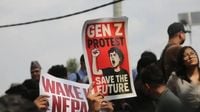In the early days of September 2025, Nepal became the unlikely epicenter of a political earthquake that sent ripples far beyond its mountainous borders. What began as a youth-led protest against new restrictions on digital freedoms quickly escalated into a full-blown uprising, toppling the government of Prime Minister KP Sharma Oli, plunging the country into a constitutional crisis, and forcing the world’s major powers to recalibrate their approach to the Himalayan nation.
The so-called "Gen Z Revolt" was remarkable not just for its speed and intensity, but for its origins and symbolism. According to The Wire, thousands of young Nepalis—most in their early twenties, and all digital natives—flooded the streets of Kathmandu, demanding democracy, transparency, accountability, and digital freedom. Their anger was ignited by the Oli administration’s attempt to ban social media, curb free speech, and ramp up surveillance through a controversial new cyber law. In a matter of just two days, the protests toppled the powerful coalition led by the Communist Party of Nepal (Unified Marxist-Leninist), leaving the nation effectively leaderless from September 9 to 12.
During those chaotic days, the collapse of security was total. Key state institutions—Singha Durbar, the Parliament Building, the President’s Office, and even the Supreme Court—were set ablaze. The speed and scale of the unrest stunned not only Nepalis but also their neighbors and powerful friends abroad. As The Wire noted, for the first time in Nepal’s history, the country was without a functioning government until former Chief Justice Sushila Karki was sworn in as Prime Minister on September 12.
How did the world react to Nepal’s sudden turn? The answer reveals much about the shifting geopolitics of South Asia and the anxieties of its biggest players.
India was the first to publicly respond. On September 9, as violence peaked, Prime Minister Narendra Modi called the "unfolding violence in Nepal...heart-wrenching" and urged the restoration of peace. That same day, he convened a Cabinet Committee on Security to assess the potential impact on India, which shares an open border and deep cultural ties with Nepal. After Karki assumed office, India’s Ministry of External Affairs promptly welcomed her appointment, expressing hope that it would "help in fostering peace and stability" and reaffirming India’s commitment to working closely with Nepal "for the well-being and prosperity of our two peoples and countries." Since then, India has resumed normal engagement, even signing new agreements for cross-border transmission lines—a sign that bilateral relations are returning to business as usual.
The United States, meanwhile, took a more measured approach. On September 14, the U.S. Embassy in Kathmandu welcomed the "restoration of calm and a peaceful resolution" after the tragic events, and commended both President Ram Chandra Paudel and youth leaders for their "commitment to a democratic solution." The U.S. also recognized the Nepal Army and Chief of Army Staff General Ashok Raj Sigdel for their "vital role" in restoring order and enabling a peaceful transition. On September 18, U.S. Ambassador Dean Thompson met with Prime Minister Karki to reaffirm support for Nepal’s "peaceful, democratic path forward." Secretary of State Marco Rubio followed up on September 20, congratulating the Nepali people on Constitution Day and voicing U.S. support for "transparent governance that adheres to the constitution." As The Wire highlights, these actions reflect an endorsement of the political system established by Nepal’s 2015 constitution and a desire to see elections proceed smoothly next year.
China’s response stood in stark contrast. Beijing, which had invested heavily in Nepal’s leftist political environment since 2015—offering political training, ideological exchanges, and support for the unification of Nepal’s communist parties—was caught off guard. The Gen Z uprising, as The Print reported, was a spontaneous, leaderless movement that rejected not only the old guard but also the political culture China had quietly nurtured. Where previous political movements in Nepal had been led by communists, this revolt was fueled by memes, digital activism, and a thirst for freedom.
China’s main concern, however, runs deeper than lost political influence. The presence of some 15,000 Tibetan refugees in Nepal and the risk of renewed Tibetan activism have always made Beijing wary of instability in its southern neighbor. As Vijay Kant Karna, Executive Chairperson of the Centre for Social Inclusion and Foreign Policy, put it, "China is a one-party dictatorship. Nepal is a multi-party democracy. In democracy, you cannot arrest someone just for demanding a free Tibet. That is exactly why China prefers a communist government and not democracy in Nepal. Oli’s government was actually very accommodating to China’s demands."
Following the protests, China’s reaction was notably restrained. On September 14, the Chinese Foreign Ministry issued only brief congratulations to Karki, stating that China "respects the development path chosen independently by the people of Nepal." Unlike previous transitions, no formal messages came from China’s top leaders—a sign of Beijing’s displeasure and uncertainty. The situation was further complicated when the Dalai Lama sent a congratulatory message to Karki, a highly unusual move that set off alarm bells in Beijing. Nepali media also reported possible involvement of Tibetan groups in the protests, prompting the new government to reaffirm Nepal’s commitment to the One China policy and to reassure China that no anti-China activities would be tolerated on Nepali soil.
As The Print observed, China is now in "wait and watch" mode, wary of any move that could provoke backlash or further erode its standing among Nepal’s increasingly assertive youth. The Belt and Road Initiative (BRI) projects, once seen as symbols of unbreakable China-Nepal ties, are now in limbo. The Pokhara Regional International Airport, built with Chinese loans, faces controversy over debt sustainability, and the ambitious cross-border railway to Tibet is little more than a political talking point. For Beijing, the stakes are high: a withdrawal could hand influence to India and the U.S., while overreach risks alienating a generation of Nepalis who prize sovereignty and transparency.
Back in Kathmandu, the Karki administration has moved swiftly to outline its priorities: fighting corruption, preparing for elections, and managing post-crisis economic recovery. On October 17, Karki held a diplomatic briefing to court international support for elections scheduled for March 5, 2026, and for reconstruction of infrastructure damaged during the September protests. Yet, as The Wire notes, the path ahead remains fraught. The government’s controversial decision to recall ambassadors from 11 countries—including China, the UK, and the U.S.—has caused friction both at home and abroad, especially since the Supreme Court issued an interim order against the move. Major political parties remain hesitant to commit to elections, citing ongoing security concerns, while the international community is watching closely to see if the political environment will allow free and fair polls.
For now, Nepal stands at a crossroads. The Gen Z uprising has upended old certainties and forced a generational reckoning not just within the country, but across the region. As Karna aptly put it, "For now, Beijing is watching. Waiting. And wondering how a generation armed only with hashtags and hope managed to shake the Himalayan chessboard." The world is watching, too, as Nepal’s youthful revolutionaries chart a new course for their country—one that could have consequences far beyond the shadow of the Himalayas.




